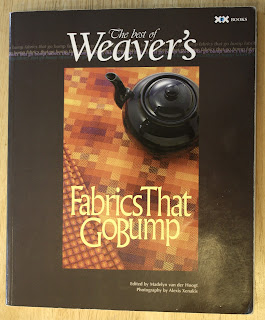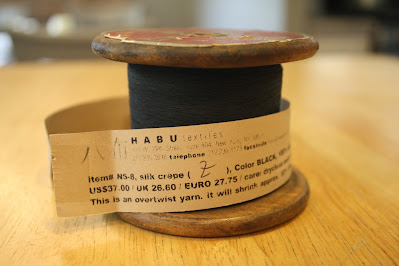Sampling on 16 shafts with different wefts (top to bottom):
S-twist linen crepe, Z-twist silk crepe, 60/2 spun silk
16-shaft sample with 60/2 silk weft after washing (and coaxing the pleats to curve)
Same sample with pleats before washing
Take note: I wove these samples on the end of a black-and-white warp that was left over from another project. Really, I was just curious about how to weave curving pleats. No way would I use black and white yarns if I were weaving this for a garment!
Anyhow, I'll get to the point. As we all know from that inspiring book, Fabrics That Go Bump, when you weave a turned twill on 8 shafts or more, you can create vertical pleats. The secret lies mainly in the structure, which is basically a turned twill that alternates between weft-emphasis and warp-emphasis blocks.
Here's a look at a design from this book by the late, great Erica de Ruiter. I found it inspiring.
De Ruiter designed her treadling in the liftplan, which looks like this.
I think it's ingenious -- but I decided to use a networked curve instead, which looks like this in the liftplan.
Truthfully, I think de Ruiter's design is better, as there are more warp floats per pleat. But why compare? The important factor is that both designs allow for floats of three in the warp yarns alternating with floats of three in the weft yarns.
How does this structure create pleats? It's the mechanics of how yarns relax after washing, really. The weft floats (in white on both drafts) relax and draw in, creating a concave shape, pulling on the warp floats on the other side (which are vertical, so they align vertically, sort of like Venetian blinds folding up on themselves, and create convex pleats).
The ratio of grists -- warp vs. weft -- can help with this effect, in my experience. In my sample at the beginning of this post, the warp is 20/2 cotton threaded in black and white at 8,400 yards/pound, while the weft at the bottom of the photo is 60/2 silk in black at 14,800 yards per pound. So the ratio in grist of warp to weft is about 5:3. I prefer a ratio of about 2:1, but I didn't have any other yarns in my stash. (You know how that goes.)
Another way to achieve pleats is to use the same design (warp floats alternating with weft floats) with an "energized" or "active" weft, such as crepe or overtwist or elasticized yarn. First, I tried an S-twist linen crepe from
Lunatic Fringe. (You'll see this sample, vaguely, at the top of the photo at the beginning of this post.)
The sample is definitely textured and pleated, but you can't see curves at all.
I don't really have a theory on this, other than that the yarn draws the warp in so much that the curves are lost because they are too subtle.
The same thing happened when I tried silk-crepe yarn from
Habu, a Z-twist gossamer-weight yarn that's about 33,000 yards/pound (and not at all fun to wind on a pirn, because it's constantly plying backwards on itself). The photo at the beginning of this post shows this sample in the middle of the fabric.
The spool above has lasted forever: I purchased it back in the day when Habu was based on West 29th Street in Manhattan! This yarn shrank the sample about 50% width-wise -- again, overkill as far as the curves I was looking for.

What did I learn from this? 1) That it's useful to design in the liftplan, especially when you want precise curves and patterns. 2) That you don't necessarily want to use active yarns for collapse effects, especially when you're working with turned twills. 3) That sampling, sampling, and sampling some more always pays off.
Perhaps, like me, you tuned in to "Textiles and Tea" with Kathi Grupp from
HGA interviewing
Anita Luvera Mayer on Tuesday, June 21. That was a big part of Anita's message: We need to sample and, even if we feel our samples aren't successful, we have learned something, so we've moved forward. I've certainly learned something, even if I'm not thrilled with the results.... But then again, maybe a long scarf with curving pleats, using de Ruiter's liftplan along with a variety of active and inactive yarns in the warp? In beautiful colors?
Thanks for reading!















3 comments:
I really like looking at the black-and-white samples: I can see the weave structure more easily than when there are multiple hues. Thank you for laying out your working process here; it's very helpful.
Do you think that "Fabrics that Go Bump" would be a helpful purchase for someone with only 8 shafts?
Ruth,
Yes, definitely, if you're interested in textural weaving. What I love about it is the changes that take place in the finishing process: You can't always predict the results and these techniques can create very natural, organic curves and shapes. It's a great book!
Best,
Denise
Thank you! I will look for a copy. . .Ruth
Post a Comment